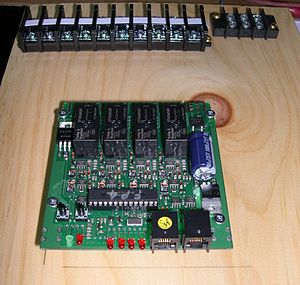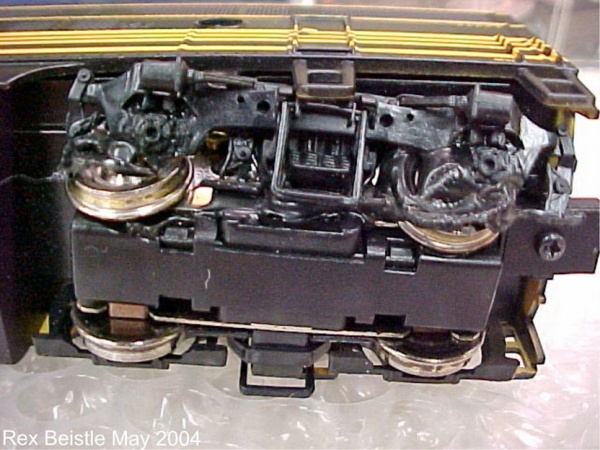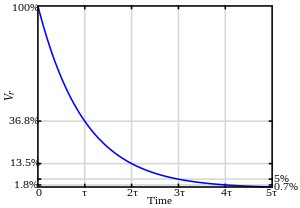Short Circuit
Summary: A Short Circuit gets its name from the electrical energy finding a shortcut, an easier path from one side of the power supply to the other.
|
See the Video. |
Protecting your layout from the excessive currents which flow during a short circuit event prevents damage to your models and Digital Command Control System. It doesn't take much time or current to cause the damage shown below.
- Not to be consfused with Inrush Current, a sudden surge of current caused by the Energy Storage circuits used with Multifunction Decoders causing the booster's overcurrent protection to trip. For more information see Inrush Current.
What is a Short Circuit?
A Short Circuit (or simply a short) gets its name from the electrical energy finding a shortcut, an easier path from one side of the power supply to the other. And it will always take the easy way when it finds it. The last thing you want is to be part of that easy return path on a High Voltage circuit. Doing so, it bypasses the load which is restricting the current flow.
A short circuit is bad. Unchecked, it will melt your power supply, wiring, plastic railroad ties, etc., and worst case may cause a fire. For this reason, all commercial model railroad power supplies (analog or DCC) have some form of short circuit protection built in.
Using an ordinary fuse for protecting track power supplies can be burdensome when shorts occur often enough to require changing fuses constantly. Instead, electronic protection methods are used which recover automatically when the short is removed.
- Some DCC Boosters lack any form of overcorrect protection on their outputs. Always read the manual, and purchase appropriate over current protection devices if needed.
Causes
There are a number of things that can create a short circuit:
- A metal object bridging the track such as a tool or watch strap
- A derailment - either a locomotive or some other rolling stock shorting opposite phase rails
- Driving into a live frog turnout set against you
- A reversing loop or any other arrangement of track that allows a train to end up going back the way it came
- A locomotive crossing between power districts which are not in phase
- Bad track wiring – for example, uninsulated feeder wires coming into contact
- Bad decoder installation – resulting in the track pickups shorted together
- Non–DCC Friendly Turnout combined with out-of-spec rolling stock causing a short in the turnout
Some actual reported causes from a Lenz newsletter:
- Tools across the track
- Faulty Switches
- Metal frame eye glasses
- Sleeping wet cat
- Crossed feeders
- Can of Coke
- Stop Watch on track
- Spilt Coffee
- Spiral note book
- Freshly glued ballast
- Soldering station
- Leaf Rake (Only applies if you railroad outdoors.)
Why Should I Care?
Why worry about short circuits when DCC boosters have built-in protection? If you are operating a larger layout there are two big reasons why you should not just rely on your booster:
- A booster tripping will shut down the entire booster district and all the trains running on it will immediately stop. This can be very embarrassing on a club layout because whatever mistake the operator made will be immediately obvious and annoying to all the other operators.
- The booster's over current protection is intended to protect the booster itself.
- A large booster could supply up to 5 amps continuously without tripping. With poor quality wiring this current may be the result of a short, so 5A will be flowing continuously through whatever is causing the short. This might include fine gauge locomotive pickup wiring which could overheat and melt the plastic insulation.
Short Circuit Protection
Booster Trips
As mentioned earlier, many DCC boosters include electronic short circuit protection. Depending on the design these will trip either when a certain level of current is exceeded or a sudden increase in current draw occurs.
This is one good reason why you want to use reasonably heavy gauge wiring for the track power bus on a medium to large layout. If you only use light gauge hook-up wire (say 22 AWG gauge) for a 40' track bus, the DC resistance (there and back) will be about 1.3 Ohms. Not in itself enough to prevent the booster tripping, but getting into the right ballpark, and it certainly won't help. Excessive resistance and inductance on the power bus will impede the operation of the breaker.
Rate of Change
Many boosters use rate of change to detect a short circuit. This method is very fast and effective in preventing damage. Should the current change by more than a set amount in a fixed period of time, the circuit protection system will take action.
If there are a number of sound equipped locomotives on the track, the booster may trip upon powering up the track or when recovering from a previous incident. The surge of inrush current[1] to charge up any capacitors[2] in the locomotives will be interpreted as a short circuit. This can also be an issue with energy storage devices installed in your locomotives. A few may not cause problems, but as more join the fleet their inrush current may exceed the booster's tolerance for a spike. As the capacitors charge their inrush current decreases. Commercial offering may include additional components to reduce the inrush current.[3]
Many boosters have the ability to change the response time, there may be a CV in the booster to extend the short circuit time period before it reacts. This is often necessary with nuisance trips (such as a high inrush current) or to prevent the booster from acting before a power management or autoreversing device has acted.[4]
Test Your Track Wiring
You should test your track wiring by doing the Quarter Test. If the test fails, your wiring is causing the problem and must be corrected. Excessive inductance will slow the rate of change in current, reducing the effectiveness of the over current protection.
Auto Reversing Booster
If you use two or more boosters on your layout then all except one should be auto reversing. This save having to worry about matching the phase of booster power district. Otherwise, a locomotive crossing between districts will cause two boosters to fight each other - effectively the same thing as a short circuit.
It is very important that at the boundary of a booster district only one booster is capable of phase reversal.
Read the instructions as you may need a return path between the boosters to ensure proper operation of the auto reverse function
Auto Reversers
If the layout has any way for a train to go out and return so that it ends up facing in the opposite direction on the same piece of track that it started, then you have a short circuit. This might be a reversing loop or balloon track, a reversing triangle (Wye), a turntable or a crossover on a "dog-bone" layout.
Obviously, to prevent a hard short circuit, the track must be double gapped at appropriate places. But a short circuit will still occur when a locomotive crosses the gaps going into a reversing section. This can be solved with a DCC auto reversing module.
Circuit Breakers

Circuit breakers can be used to cut the power to sub-districts of a booster district when a short circuit is detected. This mitigates the effect of a short circuit by reducing how much of the layout gets shut down by an operator making a mistake.
This is a much cheaper solution than adding additional boosters.
The Digitrax PM42 Power Management System is an example of a multiple output circuit breaker.
There are disadvantages to using circuit breakers:
- They don't prevent short circuits, they just reduce the effect
- They are complicated to retrofit because the track power buses must be divided up into separate sub-districts and additional heavy gauge wire has to be run to each sub-district power bus.
Current Limiting Devices
You will often hear solutions involving inserting a resistor (regular or PTC (Positive Temperature co-effficent) fuse) or automotive lamp in series with the track to limit the current if a short occurs. [5]
Not a good idea. Short circuit protection should disconnect the source of power until the issue is found and corrected.
Limiting the current is not solving the problem. Fuses protect your equipment from damage should something short out. Replacing the fuse repeatedly isn't solving the problem. Eliminate the cause of the short first. Use an NMRA gauge to check turnout clearances and that your wheels are in gauge.
Since many DCC systems can supply upwards of five amps, limiting the current via an additional impedance means that not all the current can flow through the short. You may still have three or four amps flowing. This solution worked fine in the days of analog control with low current. DCC boosters have much higher current capability.
Additional impedance in the DCC track circuit can negatively affect operation of over current devices present in the booster, as well as power management devices.
Automotive Lamps
This idea appeared in the 1960s, using taillight bulbs to limit current. When a low current is flowing the filament has a low resistance with a minimal voltage drop. In the days of analog control multiple low current power supplies were used to provide power to the layout's cabs. So, the idea had some merit. The typical 1156 lamp would draw ~2.5A at full brightness, so when a short occurred it limited the current and glowed brightly.
- NMRA Data Sheet D7q mentions using 12V lamps to limit current, yet advises against using lamps in a high current environment. It recommends them only in low current (less than 1A) situations. As DCC systems typically supply 3 or more amps, this method is not appropriate. This is an analog solution to an analog problem, and should stay in that realm.[5]
Why is this not a good idea with DCC?
- DCC boosters supply more current, typically 5A, and will trip before the lamp does anything.[5]
- If you are protecting multiple power districts with multiple lamps, the booster may shut down when two or more shorts occur.
- When the lamps cool, the booster will re-energize the track, immediately shut down, re-energize...
- This technique limits the current. The maximum current will be the limited by the lamp's resistance. Meanwhile, about 2.5A of current is still flowing, the longer it flows the more damage is possible. If not cleared promptly, the short will do damage.
- The bulbs themselves get hot. More than enough to melt or scorch something nearby. Given enough time or flammable material nearby, this may cause a fire.
Again, this does not solve the problem, it just masks it. Eliminating the cause of the short is the only solution.
Safety and Warranty Issues
As the addition of a current limiting device will interfere with the proper operation of the booster's built in over-current protection, the manufacturer of your DCC system or booster may void any warranties if such devices were used with their DCC equipment.
DCC Starter Sets with low current boosters do not output enough current to light a lamp during a short circuit. These systems are typically supply three amps or less, which is insufficient to light the 1156 lamp. The lamp could actually prevent the booster from shutting down, with the potential to damage its output circuitry from excessive heat. The additional load could also cause the booster's output to cycle on and off repeatedly until the short is cleared, which can again damage the booster.
- Lenz will void your warranty if you render their circuit protection useless by using lamps.
Frog Juicers
Electronic Frog Juicers not only solve the problem of getting the frog phasing correct for live frog turnouts, partially solving the problem of the operator making the common mistake of running the wrong way into a turnout (i.e. the switch set against the train) thereby causing a short. If this happens, the frog juicer will automatically correct the phase and no short will occur. It does nothing to guarantee that the train won't derail and then cause a short via a locomotive wheel touching the opposite rail.
Videos
Additional Reading
DCC Short Circuit Lamps by Dick Bronson
References
- ↑ The sudden spike of current triggers the protection circuit.
- ↑ Capacitors require 5 time constants (1 time constant = Resistance x Capacitance) to charge, at a rate of ≈60% per time constant, to reach full charge.
- ↑ A small choke (inductor) in series with the capacitor can be used to limit the current. This is often used to prevent the energy storage circuit from interfering with programming operations on the programming track.
- ↑ Another solution is additional resistance which can be switched out of the circuit.
- ↑ 5.0 5.1 5.2 TN-9: Although in the past some have used 12VDC automotive tail light bulbs to protect against short circuits, today there are circuit breakers that are much faster and can be set for various trip currents and response times. It is no longer recommended to use tail light bulbs for short circuit protection. (NMRA Technical Note)

